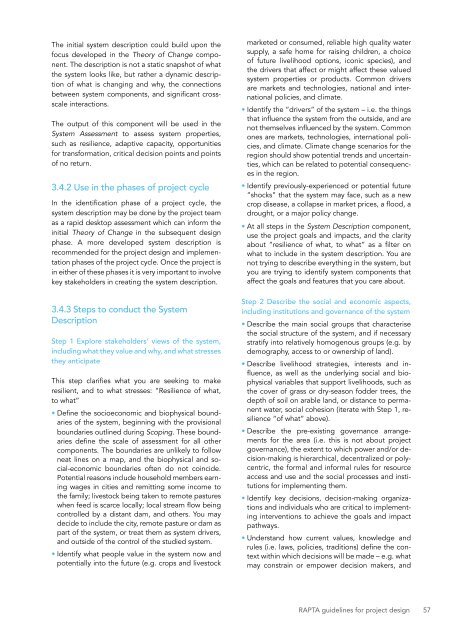DESIGNING PROJECTS IN A RAPIDLY CHANGING WORLD
srun3013fp1
srun3013fp1
You also want an ePaper? Increase the reach of your titles
YUMPU automatically turns print PDFs into web optimized ePapers that Google loves.
The initial system description could build upon the<br />
focus developed in the Theory of Change component.<br />
The description is not a static snapshot of what<br />
the system looks like, but rather a dynamic description<br />
of what is changing and why, the connections<br />
between system components, and significant crossscale<br />
interactions.<br />
The output of this component will be used in the<br />
System Assessment to assess system properties,<br />
such as resilience, adaptive capacity, opportunities<br />
for transformation, critical decision points and points<br />
of no return.<br />
3.4.2 Use in the phases of project cycle<br />
In the identification phase of a project cycle, the<br />
system description may be done by the project team<br />
as a rapid desktop assessment which can inform the<br />
initial Theory of Change in the subsequent design<br />
phase. A more developed system description is<br />
recommended for the project design and implementation<br />
phases of the project cycle. Once the project is<br />
in either of these phases it is very important to involve<br />
key stakeholders in creating the system description.<br />
3.4.3 Steps to conduct the System<br />
Description<br />
Step 1 Explore stakeholders’ views of the system,<br />
including what they value and why, and what stresses<br />
they anticipate<br />
This step clarifies what you are seeking to make<br />
resilient, and to what stresses: “Resilience of what,<br />
to what”<br />
• Define the socioeconomic and biophysical boundaries<br />
of the system, beginning with the provisional<br />
boundaries outlined during Scoping. These boundaries<br />
define the scale of assessment for all other<br />
components. The boundaries are unlikely to follow<br />
neat lines on a map, and the biophysical and social-economic<br />
boundaries often do not coincide.<br />
Potential reasons include household members earning<br />
wages in cities and remitting some income to<br />
the family; livestock being taken to remote pastures<br />
when feed is scarce locally; local stream flow being<br />
controlled by a distant dam, and others. You may<br />
decide to include the city, remote pasture or dam as<br />
part of the system, or treat them as system drivers,<br />
and outside of the control of the studied system.<br />
• Identify what people value in the system now and<br />
potentially into the future (e.g. crops and livestock<br />
marketed or consumed, reliable high quality water<br />
supply, a safe home for raising children, a choice<br />
of future livelihood options, iconic species), and<br />
the drivers that affect or might affect these valued<br />
system properties or products. Common drivers<br />
are markets and technologies, national and international<br />
policies, and climate.<br />
• Identify the “drivers” of the system – i.e. the things<br />
that influence the system from the outside, and are<br />
not themselves influenced by the system. Common<br />
ones are markets, technologies, international policies,<br />
and climate. Climate change scenarios for the<br />
region should show potential trends and uncertainties,<br />
which can be related to potential consequences<br />
in the region.<br />
• Identify previously-experienced or potential future<br />
“shocks” that the system may face, such as a new<br />
crop disease, a collapse in market prices, a flood, a<br />
drought, or a major policy change.<br />
• At all steps in the System Description component,<br />
use the project goals and impacts, and the clarity<br />
about “resilience of what, to what” as a filter on<br />
what to include in the system description. You are<br />
not trying to describe everything in the system, but<br />
you are trying to identify system components that<br />
affect the goals and features that you care about.<br />
Step 2 Describe the social and economic aspects,<br />
including institutions and governance of the system<br />
• Describe the main social groups that characterise<br />
the social structure of the system, and if necessary<br />
stratify into relatively homogenous groups (e.g. by<br />
demography, access to or ownership of land).<br />
• Describe livelihood strategies, interests and influence,<br />
as well as the underlying social and biophysical<br />
variables that support livelihoods, such as<br />
the cover of grass or dry-season fodder trees, the<br />
depth of soil on arable land, or distance to permanent<br />
water, social cohesion (iterate with Step 1, resilience<br />
“of what” above).<br />
• Describe the pre-existing governance arrangements<br />
for the area (i.e. this is not about project<br />
governance), the extent to which power and/or decision-making<br />
is hierarchical, decentralized or polycentric,<br />
the formal and informal rules for resource<br />
access and use and the social processes and institutions<br />
for implementing them.<br />
• Identify key decisions, decision-making organizations<br />
and individuals who are critical to implementing<br />
interventions to achieve the goals and impact<br />
pathways.<br />
• Understand how current values, knowledge and<br />
rules (i.e. laws, policies, traditions) define the context<br />
within which decisions will be made – e.g. what<br />
may constrain or empower decision makers, and<br />
RAPTA guidelines for project design 57


